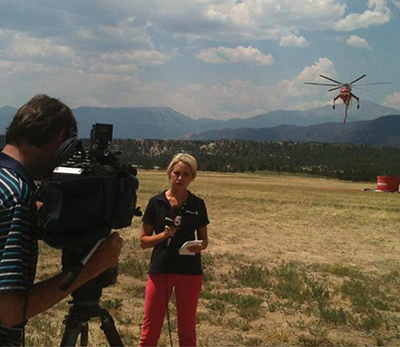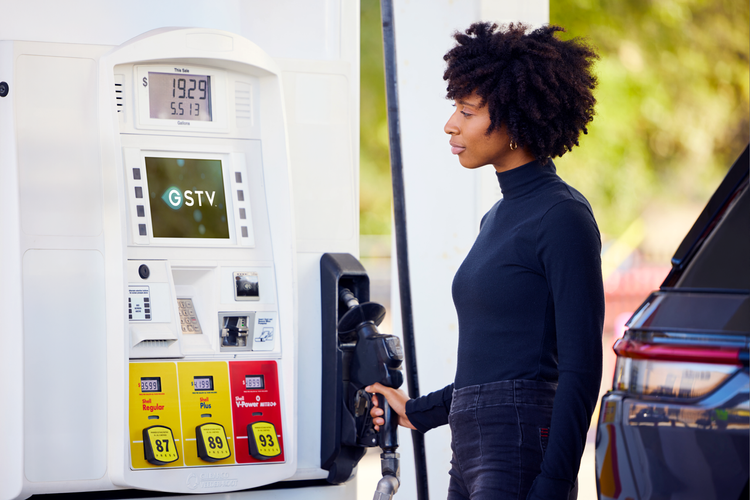Colorado Stations Step Up

KOAA Reporter Jacqui Heinrich at a staging ground for firefighting helicopters.
COLORADO SPRINGS and DENVER, COLO. -- News professionals in Colorado Springs, Colo., were having a typical Saturday on June 23—heading to Home Depot, watching their kids’ soccer games, entertaining out-of-town guests—when a suspicious plume of smoke was seen spiraling up from nearby Waldo Canyon. From that moment on, all regular day-to-day activity was suspended for a week, while the community kept its collective eyes on the nearby mountains.
That fire—which ultimately burned 18,000 acres and 346 homes, and killed two people—had just been contained when a fire of a different sort broke out: at the midnight showing of “The Dark Knight Rises” on Thursday, July 19, an armed gunman opened fire on a crowded theater in the Denver suburb or Aurora, killing 12 people, including a six-year-old girl, and injuring 58 others.
For both major stories, Colorado’s local TV stations were immediately on the scene to capture the news. And perhaps more importantly, the stations covered both stories across the digital media landscape, giving citizens a 24/7 connection to information and access whether they were in front of their televisions or not.
‘HYPER-OVERDRIVE’
“We were in hyper-overdrive on all of our social media platforms during the fire,” said Nick Matesi, vice president and general manager of Gray’s KKTV in Colorado Springs. He was recently named to this year’s annual list of B&C Digital All-Stars. “Social media is all about engagement. You have to talk with people. It can’t just be a platform to put out your content, it has to be a vehicle for conversation.”
Michael Langley, news director at Cordillera’s KOAA Colorado Springs, said, “We have mobile, online, Facebook and Twitter. Keeping people informed 24 hours a day is very easy for news outlets to do nowadays.”
Unlike local KRDO and KKTV, KOAA did not go wall-to-wall with coverage of the fire, but, Langley said, “there was always information to be found on all of our platforms. If my talent wasn’t on-air at a particular moment, we were crawling information.”
Get the TV Tech Newsletter
The professional video industry's #1 source for news, trends and product and tech information. Sign up below.
While all of the area’s TV stations made heavy use of their websites, Facebook pages and Twitter feeds, Michael Sipes, news director at News-Press & Gazette’s KRDO in Colorado Springs, said it was an old-school technology that people most relied on: radio. News-Press & Gazette also owns a radio station in the market that broadcasts on 105.5 FM and 1240 AM. While 26,000 people were being evacuated from the Mountain Shadows neighborhood on the evening of June 26, most of them were driving out and listening to their car radios.
“When it really hit the fan, radio was probably our best friend, and it was the best friend of people coming out of the neighborhood who had to be evacuated in a very hasty fashion,” Sipes said. “People can’t drive their cars and look at Facebook or Twitter on their cellphones, but they can certainly listen to the radio. Even Twitter is too slow compared to radio when you are in your car and being told to evacuate your home.”
Meanwhile, all three stations— KKTV, KRDO and KOAA—had people monitoring their Facebook and Twitter feeds 24/7 during the fire in an effort to stay up to the minute.
“My goal has always been to respond to people within an hour if they post to our Facebook wall or on Twitter, and within 10 minutes is really our hyper-goal,” said KKTV’s Matesi.
KRDO received so many photos from viewers that it had to assign a separate producer just to track and post them, Sipes said.
IN THE LINE OF FIRE
The state’s spate of wildfires had just died down when James Holmes snuck into the midnight showing of the Batman movie in Aurora, and started shooting. The tragedy took place so late that most Coloradoans only learned of it upon waking on Friday, but Gannett’s monster station in Denver, NBC affiliate KUSA, was on it right away.
“When I got called in to the station at 1:30 a.m. that night, KUSA was the only station in the state that had something posted on its website,” said KRDO’s Sipes. “At 2:30 a.m. you would have thought it was 2:30 p.m., they had so many people on the site. They were awesome.”
Both events, which also were widely covered by the national media, forced Colorado’s TV stations to get on top of their game and stay there, using every tool at their disposal to inform viewers.
“In times of community crisis like these two events were, people don’t choose to watch the news, they need to watch the news,” said KOAA’s Langley. “They have to get it fast and accurately and that’s what we do.”
